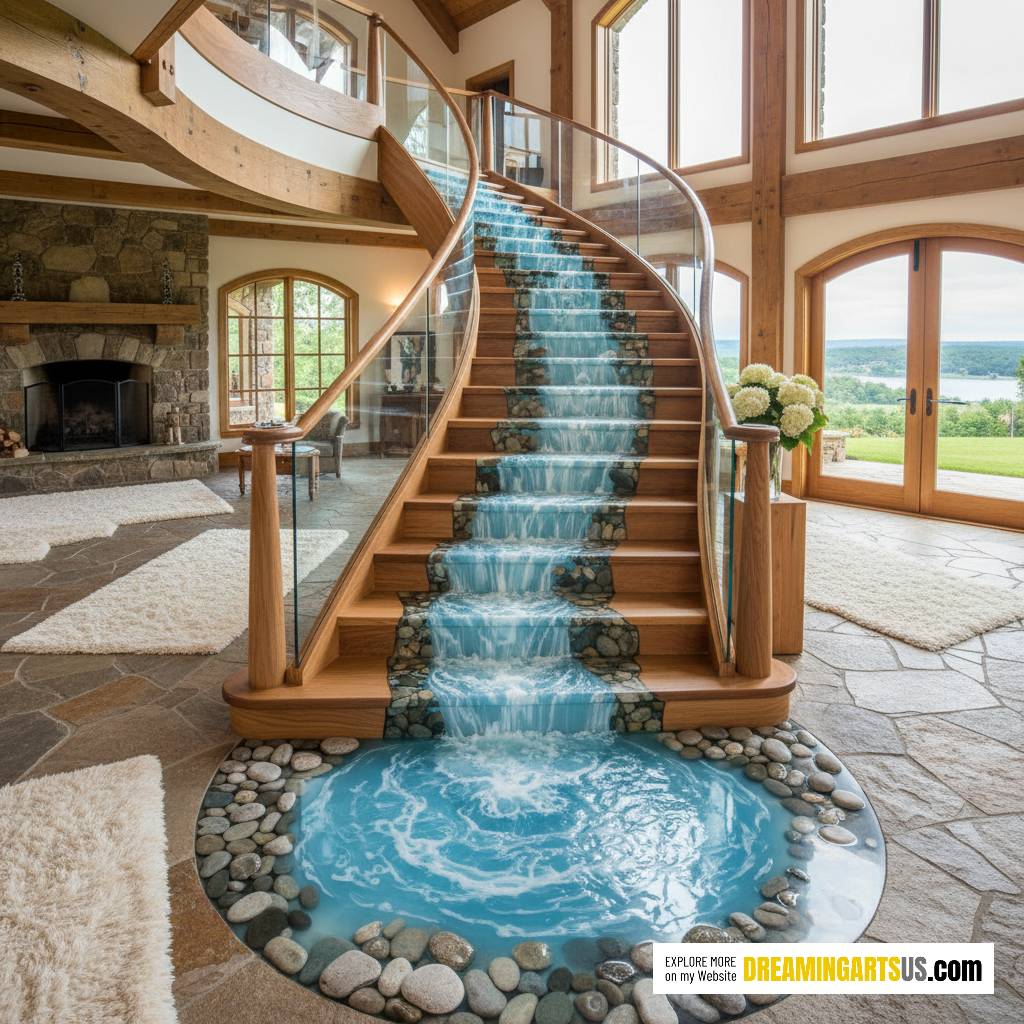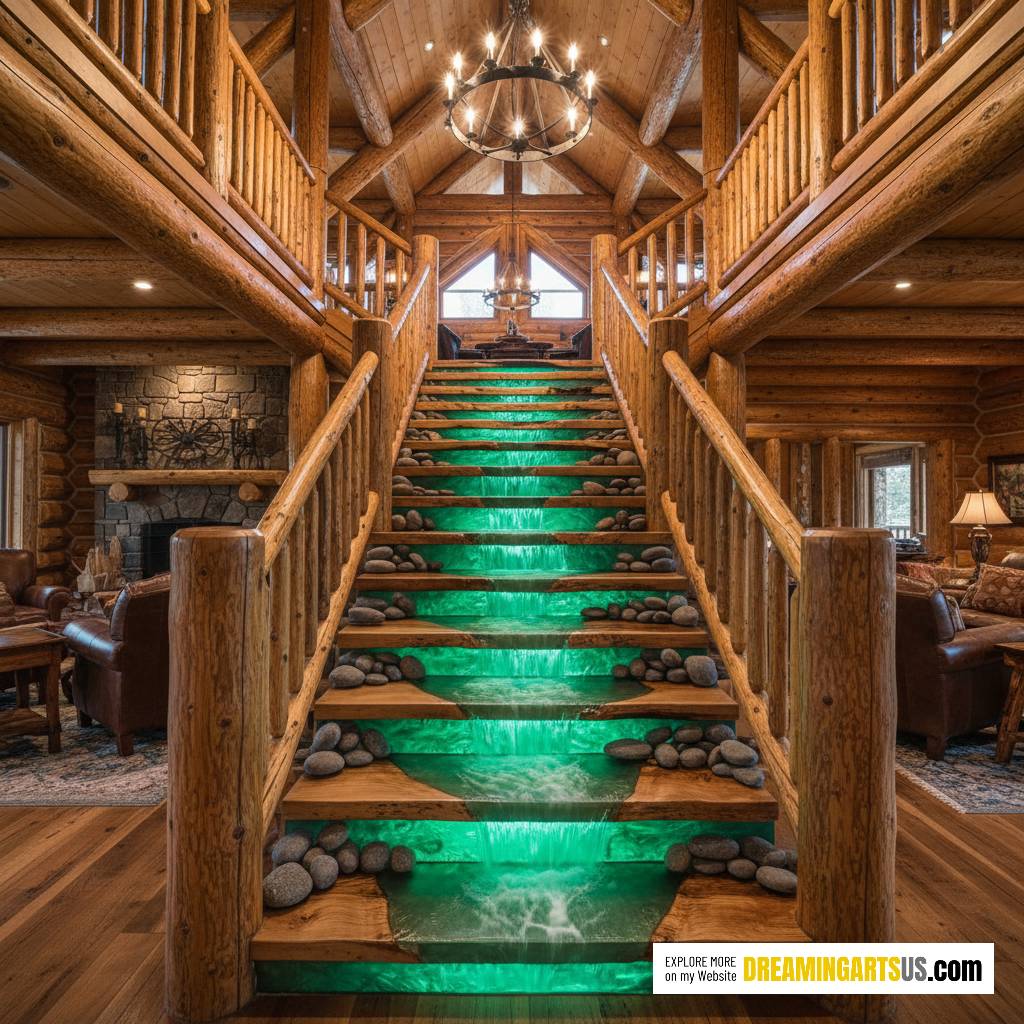When you think of breathtaking interior design, few features can compete with the visual allure of an Epoxy River Staircase. These staircases bring the elegance of natural materials and the artistry of liquid epoxy resin together—creating a design that feels like walking up a living, flowing river. Whether installed in modern homes, mountain lodges, or luxury resorts, this sculptural centerpiece transforms any interior into an extraordinary space.
In this article, we’ll dive into every essential aspect—materials, cost breakdown, design options, and customization tips—to help you understand how an Epoxy River Staircase can redefine your home’s visual identity.

What Is an Epoxy River Staircase?
An Epoxy River Staircase is a masterpiece that combines the durability of hardwood with the fluid beauty of transparent or tinted epoxy resin. The result is a staircase that appears to have a flowing river or waterfall running through its treads or sides. Often enhanced with embedded stones, LED lighting, and glass accents, this type of staircase creates an illusion of movement and depth that feels both organic and luxurious.
The name “river” comes from the way epoxy is poured—between slabs of wood or stone—to resemble a meandering stream. Each step becomes part of a visual flow, allowing the design to evoke tranquility, nature, and movement within the home.
The Artistic Appeal of Epoxy River Staircases
What makes an Epoxy River Staircase so visually captivating is its seamless balance between natural elements and modern craftsmanship. The resin—clear, ocean blue, emerald green, or even smoky gray—mimics the natural fluidity of water, while the surrounding wood frames provide warmth and contrast.
-
Modern homes often feature glossy epoxy steps with LED backlighting, creating a futuristic floating effect.
-
Rustic lodges prefer live-edge wood slabs paired with turquoise or green resin, producing the charm of a mountain stream.
-
Luxury villas might incorporate glass railings, polished stones, and cascading lighting for a dramatic “waterfall” effect.
An Epoxy River Staircase doesn’t just connect two floors—it becomes a storytelling element, turning the act of climbing stairs into a sensory experience.

Materials Used in Building an Epoxy River Staircase
Creating an Epoxy River Staircase involves several carefully chosen materials that define its appearance, strength, and longevity. Let’s break down the most common materials used.
Wood Selection
The base of the staircase usually involves solid hardwoods that provide structure and organic character:
-
Walnut – Known for its rich brown tones and stunning grain patterns.
-
Oak – A durable classic, offering light hues and a versatile look.
-
Maple – Smooth, pale, and elegant for contemporary interiors.
-
Cedar or Teak – Often used in rustic or humid environments for their resistance to moisture.
Each wood type gives the epoxy a unique contrast—dark woods emphasize the glow of colored resin, while light woods bring out soft transparency.
Epoxy Resin
The star of the show, epoxy resin, is a clear, durable polymer that can be tinted with pigments to resemble water, lava, or gemstones. Premium options are UV-resistant, heat-resistant, and self-leveling.
Popular finishes include:
-
Clear water effect – for a crystal stream appearance.
-
Ocean blue or turquoise – mimicking tropical waters.
-
Emerald or jade green – adding a mystical touch.
-
Black and gold swirls – for a luxurious, dramatic effect.
Decorative Accents
-
River stones and pebbles: Add texture and realism.
-
LED lighting strips: Create glowing effects at night.
-
Metal inlays or flakes: Provide shimmer and reflection.
-
Glass panels or sidewalls: Offer safety and enhance the sense of depth.
Reinforcement and Safety Components
To ensure durability, builders use:
-
Steel or aluminum frames hidden beneath the treads.
-
Tempered glass balustrades for safety and openness.
-
Anti-slip coatings to preserve usability without dulling the shine.
Step-by-Step Construction Process
The process of crafting an Epoxy River Staircase is both technical and artistic. It typically involves the following steps:
-
Design Conceptualization:
Architects and homeowners collaborate to decide on the staircase shape (straight, spiral, or curved), resin color, lighting, and material layout. -
Wood Preparation:
Hardwood planks are selected, planed, and cut. If using live edges, the natural curves of the wood define the “river’s path.” -
Mold and Frame Setup:
Builders construct molds or containment barriers for pouring epoxy, ensuring each stair maintains uniform depth and thickness. -
Epoxy Pouring:
Multiple resin layers are poured and cured over several days. Pigments, stones, and lighting wires are embedded between layers for depth. -
Sanding and Polishing:
Once hardened, each step is sanded smooth and polished to a high-gloss finish, revealing the luminous beauty of the “river.” -
Installation and Finishing Touches:
The treads are mounted onto a secure frame, and railings or LED lights are installed to complete the flowing aesthetic.
This process demands precision and patience—but the result is a functional piece of art that elevates the entire home.

Cost Breakdown: How Much Does an Epoxy River Staircase Cost?
The price of an Epoxy River Staircase varies greatly depending on size, design complexity, and materials. Here’s a detailed breakdown:
| Component | Estimated Cost (USD) |
|---|---|
| Hardwood materials | $2,000 – $6,000 |
| Epoxy resin (premium, UV-resistant) | $1,200 – $3,000 |
| LED lighting system | $300 – $1,000 |
| Metal or glass framing | $1,500 – $3,000 |
| Labor and craftsmanship | $4,000 – $10,000 |
| Total Estimated Cost | $9,000 – $23,000+ |
Factors Affecting Cost
-
Design complexity: Waterfall or curved designs are more expensive.
-
Wood type: Exotic woods like walnut or teak increase costs.
-
Epoxy volume: Thicker, layered resin sections require more material.
-
Lighting integration: RGB LED systems and custom wiring raise installation costs.
While an Epoxy River Staircase is an investment, it often becomes the signature feature of the home—adding unmatched resale and aesthetic value.
Custom Design Options
Customization is where the true beauty of an Epoxy River Staircase comes to life. Each design can be tailored to reflect personal style, architecture, and emotion.
Color and Flow Effects
-
Crystal clear rivers give a clean, modern look.
-
Deep blue waves simulate ocean currents.
-
Green jade tones evoke the serenity of nature.
-
Metallic or glow pigments produce mesmerizing depth, especially under LED lights.
Lighting Integration
Adding LED lighting beneath or inside the resin creates an ethereal, glowing river that shifts with the time of day. Many homeowners use programmable systems to adjust brightness or color to suit mood and occasion.
Edge and Shape Variations
Designers often play with the flow pattern:
-
Straight-line rivers for modern symmetry.
-
Curved, meandering streams for organic elegance.
-
Waterfall illusion where resin flows from top to bottom.
Texture and Depth Elements
Embedding pebbles, driftwood, shells, or even miniature sculptures can turn the staircase into a personalized art piece.
Themed Inspirations
-
Mountain stream: Natural stones and cool blue epoxy.
-
Tropical paradise: Sand tones, turquoise resin, and coral accents.
-
Futuristic glow: Black wood, neon blue epoxy, and LED underglow.
Installation & Maintenance Tips
While visually striking, an Epoxy River Staircase also demands care and attention to preserve its clarity and luster.
Installation Tips
-
Always work with experienced epoxy artisans.
-
Ensure subfloor stability before installing.
-
Verify resin thickness for load-bearing safety.
-
Use UV-resistant epoxy to avoid yellowing in sunlight-heavy spaces.
Maintenance Routine
-
Clean with a soft microfiber cloth and mild soap—avoid abrasive cleaners.
-
Apply a protective polish every 6–12 months to maintain shine.
-
Check LED wiring periodically for moisture or loose connections.
-
Consider resealing every 5–7 years if the surface begins to dull.
Long-Term Durability
With proper maintenance, a high-quality Epoxy River Staircase can last decades without discoloration or cracking, maintaining the same dazzling effect as the day it was installed.

Advantages of Installing an Epoxy River Staircase
Visual Impact
The most obvious advantage is its ability to transform an ordinary staircase into an architectural statement that sparks conversation and admiration.
Customization Potential
Every Epoxy River Staircase is one-of-a-kind. The colors, textures, and shapes are limited only by imagination.
Durability
Epoxy is resistant to moisture, scratches, and stains—making it practical as well as beautiful.
Enhanced Property Value
Such a feature often increases property desirability and can significantly boost resale appeal for luxury or custom-built homes.
Sustainability
By using reclaimed wood slabs and eco-friendly resin, many homeowners achieve a sustainable yet luxurious outcome.
Perfect Spaces for an Epoxy River Staircase
This design suits both contemporary and rustic environments:
-
Modern lofts and villas with open layouts and glass facades.
-
Cabins and lodges that embrace wood and natural stone textures.
-
Beach houses where the blue resin reflects the ocean nearby.
-
Luxury resorts or spas emphasizing nature and tranquility.
Pairing the staircase with matching epoxy river tables, countertops, or wall panels enhances continuity throughout the interior.
Comparing Epoxy River Staircases to Traditional Staircases
| Feature | Epoxy River Staircase | Traditional Staircase |
|---|---|---|
| Design appeal | Artistic and customizable | Standard and minimal |
| Durability | High with proper care | High but lacks visual flair |
| Maintenance | Low, easy to clean | Moderate, may need refinishing |
| Customization | Infinite color, texture, and lighting options | Limited to material choice |
| Price range | Premium ($9,000–$23,000+) | Moderate ($5,000–$10,000) |
While traditional stairs serve function, an Epoxy River Staircase serves both form and emotion—creating a daily experience rather than a simple utility.
Links to purchase similar products: Click here
Environmental Considerations
Modern epoxy formulations are becoming increasingly eco-conscious. Many brands offer low-VOC, BPA-free resins that are safe for indoor environments. Choosing reclaimed or sustainably harvested wood further reduces ecological impact, making an Epoxy River Staircase not just beautiful—but responsible.
Future Trends in Epoxy River Staircase Design
As design technology evolves, the future of epoxy-based architecture looks promising. We’re beginning to see:
-
Smart LED integration that syncs lighting with music or time of day.
-
Bioluminescent pigments that glow naturally in low light.
-
Interactive epoxy textures where motion sensors trigger rippling effects.
-
Hybrid builds combining epoxy with glass waterfalls or kinetic sculptures.
The next generation of Epoxy River Staircase design will blend digital artistry with natural inspiration—turning architecture into living art.
An Epoxy River Staircase is far more than a home feature—it’s a journey through creativity, craftsmanship, and imagination. Each step reflects the beauty of nature captured in resin, blending raw materials with light and emotion.
Whether you dream of a turquoise river meandering through walnut steps or a glowing emerald cascade that greets guests in your foyer, this design invites serenity and admiration into your everyday life. With proper planning, expert craftsmanship, and the right materials, your staircase can truly become a river of dreams.




